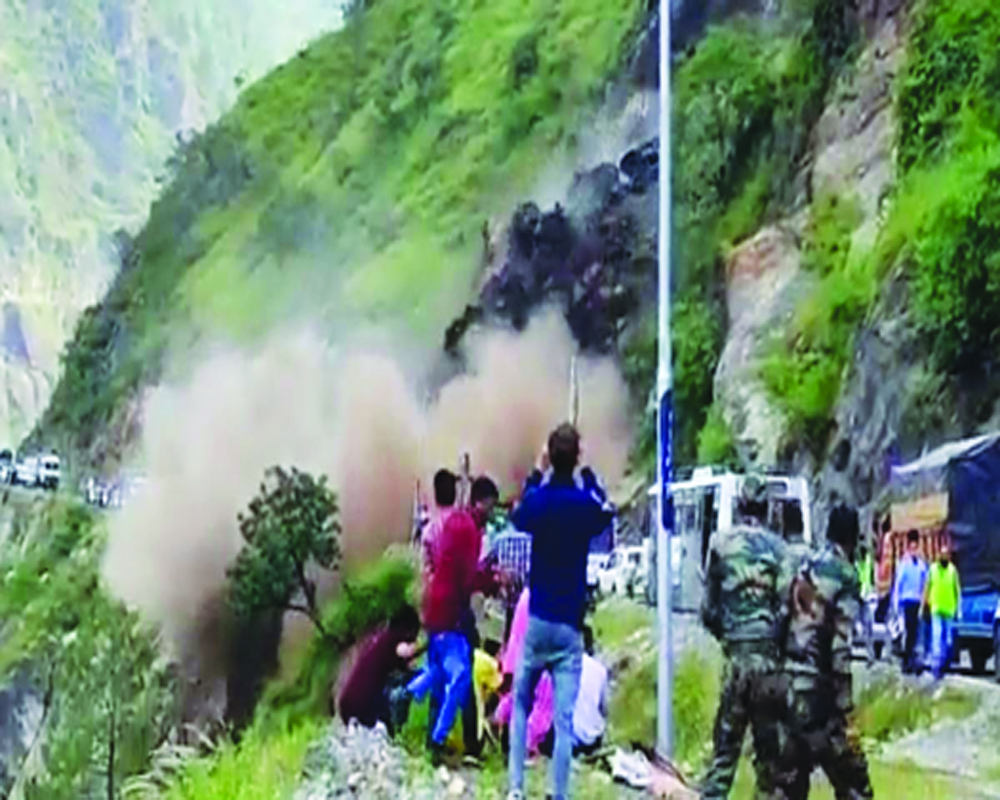Heavy construction in the eco-fragile Kinnaur and Lahaul and Spiti regions is destabilising slopes, making them more susceptible to slippage
The recent devastating flash floods and landslides in Lahaul Spiti and Kinnaur in Himachal Pradesh have once again compelled the locals to agitate against the high-handed policies of the Union and State Governments of constructing dozens of power projects on river basins to generate electricity.
Kinnaur has some of the biggest hydel projects including the 1,000 MW Karcham Wangtoo and 300 MW Baspa project which has disturbed the ecology of the region. Protesting villagers holding banners, “Save Kinnaur: No means No” have made it clear that they would not allow the construction of the proposed 804 MW Jangi Thopan hydel project. Social and cultural organisations, panchayati raj institutions and mahilamandals have come forward to register protest environmental degradation, especially through hydel power generation.
According to experts, India accounts for about 18 per cent of the total global fatalities due to landslides in Uttarakhand, Himachal Pradesh, Jammu & Kashmir and Ladakh. This region has witnessed over 65 per cent of the landslides in the country followed by the North-eastern Himalayas and the Western Ghats.
Traditionally, rain and earthquakes are known to cause a large movement of rock, soil and debris, but the construction of roads and buildings, mining and hydropower projects are now increasingly destabilising slopes, making them more susceptible to slippage. Experts have cautioned that the tribal districts of Kinnaur and Lahaul Spiti are eco-fragile and setting up of power projects there may prove disastrous for the entire region. They pointed out that Uttarakhand too has experienced the adverse effects of power projects where landslides and flash floods are a normal occurrence now. More than 16 mega and 30 micro power projects have been proposed in Lahaul Spiti on the banks of Chenab and other rivers. These power projects will also result in the melting of glaciers at a faster pace.
Till now, the toll in rain-related incidents since June 13 climbed to 381, and more than 55 persons have lost their lives in 39 landslides during this monsoon season. The maximum casualties were reported in Kinnaur (38) followed by Kangra (10), Solan (two) and Shimla (three) and Lahaul and Spiti (one each). As per the data shared by the Disaster Management Cell of the Revenue Department, 16 slides occurred in Lahaul and Spiti district, five each took place in Mandi and Shimla, three each in Solan, Kinnaur and Chamba while two landslides occurred in Sirmaur and Kangra districts. The major slides included one at Nugalsari in Kinnaur district on August 11 in which 28 persons lost their lives while 13 sustained injuries. Massive boulders triggered by landslide hit a Tempo Traveller killing nine persons and injuring three near Batseri village on Sangla-Chitkul road in Kinnaur on July 25.
Another reason for environmental degradation in the hills is due to the construction of roads and highways which, ironically, are necessity. According to KK Kapila, President Emeritus, International Road Federation, “While planning the repair of affected areas in the hills, it needs to be remembered that the outer and lesser Himalayas comprised unstable strata owing to the young folded mountains and these sections have very weak to poorly cemented sedimentary rocks that lack inherent strength”. The construction of roads, dams, and other infrastructure in such ranges and strata, regardless of extreme precautions and environment-friendly techniques that are least invasive, does not guarantee adequate protection to the foundation or the slopes; blasting, which is used as a faster and economical method of infrastructure construction, and should be avoided, he added.
Unfortunately, India is still short of a robust mechanism to respond in advance to natural disasters such as landslides and flash floods. It explains so many casualties due to these disasters. India Meteorological Department (IMD), DG, Dr Mrutyunjay Mohapatra says “There has been some progress in providing flash flood data since last year after the department inked a collaboration with the US based Hydrological Research Centre and World Meteorological Organisation”. Some baby steps have been also been taken on landslide forecasting.
The Government need to invest more on the research projects in universities which may lead to making the forecasting of landslides and flood floods possible and prevent the loss of life and property.
(The writer is a senior journalist and Chairman, Panwar Group of Institutions, Solan, Himachal Pradesh. The views expressed are personal.)
























